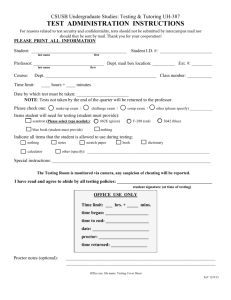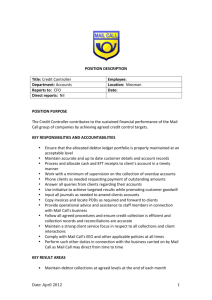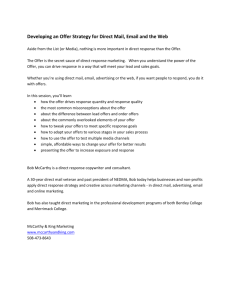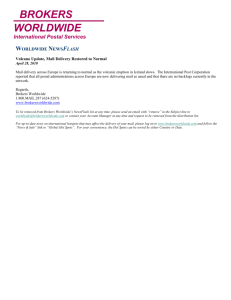CHAPTER 2 THEORETICAL FOUNDATION 2.1 Communication
advertisement
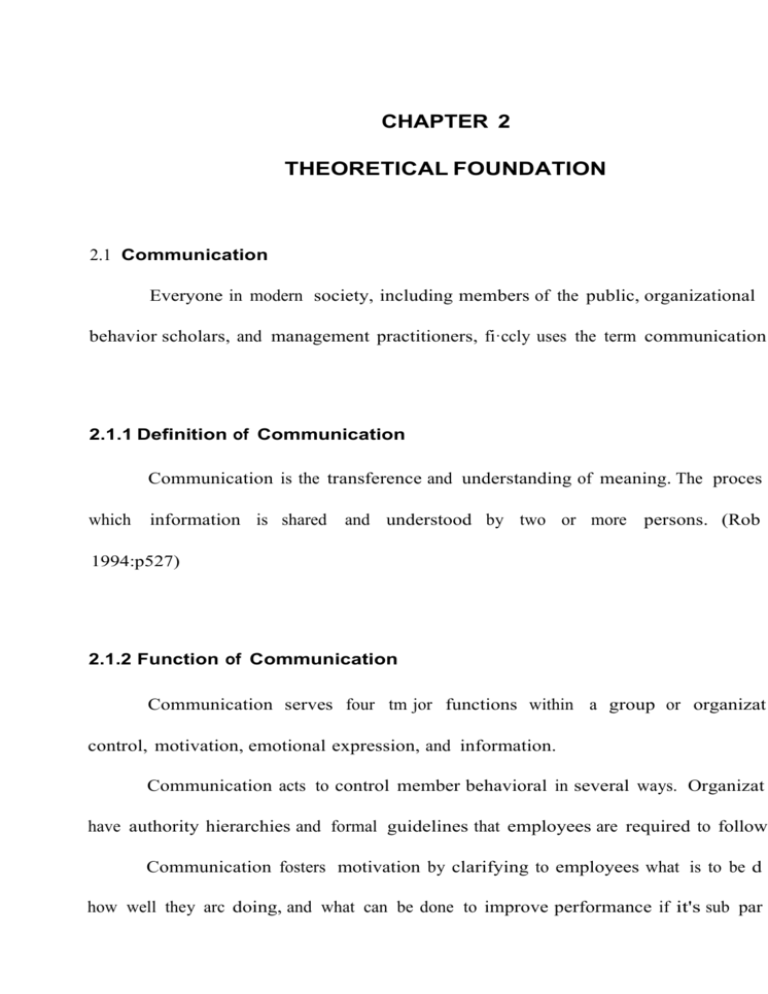
CHAPTER 2 THEORETICAL FOUNDATION 2.1 Communication Everyone in modern society, including members of the public, organizational behavior scholars, and management practitioners, fi·ccly uses the term communication 2.1.1 Definition of Communication Communication is the transference and understanding of meaning. The proces which information is shared and understood by two or more persons. (Rob 1994:p527) 2.1.2 Function of Communication Communication serves four tm jor functions within a group or organizat control, motivation, emotional expression, and information. Communication acts to control member behavioral in several ways. Organizat have authority hierarchies and formal guidelines that employees are required to follow Communication fosters motivation by clarifying to employees what is to be d how well they arc doing, and what can be done to improve performance if it's sub par 2.1.3 Process of Communication Figure 2.1 The Communication Process Model (Robbins, 1994, p379) This model is made up of seven parts: the communication source, encoding, t message, the channel, decoding, the receiver, and feedback. The source initiates a message by encoding a thought. Four conditions have described that affect the encoded message: skill. attitudes, knowledge, and the so culture system. The message is the actual physical product from the source encoding. Whe speak, the speech is message. When we write, the writing is the message. When we p the picture is message. When we gesture. the movements of our arms. the expressio our face arc message. Our message affected by code or group of symbols we u transfer meaning the content of the message itself. and the decisions we make in selec The channel is the medium through which the message travels. It is select the source, which must determine which a channel is formal and which one is inf Formal channels arc established by the organization and transmit messages that pert the job related activities of members. They traditionally follow the authority ne within the organization. Other forms of messages. such as personal or social, follo informal channels in the organization. The receiver is the object to which the message is directed. Nevertheless, b the message can be received, the symbols in it must be translated into a form that c understood by the receiver. This is decoding of the message. Just as his or her s attitudes, knowledge, and social culture system limited the encoder, the recei equally restricted. Just as the source must be skillful in writing or speaking, the re must be skillful in reading or listening, and both must be able to reason. knowledge, attitudes, and cultural background influence one's ability to receive, j they do the ability to send. The final link in the communication process is a lcedback loop. I communication source decodes the message that he encodes, if the message is put into his system, we have feedback. Feedback is the check on how successful we h transferring our messages as originally intended. It determines whether understandin been achieved. 2.1.4 Communication Channel simultaneously, 1':1cilitatc rapid feedback, and be very personaL Other arc lean in tha score low on these three factors. As picture below illustrates, face to face talks scor highest in terms of channel richness because it provides for the maximum amou information to be' transmitted during a communication episode. That is, it offers mu information cues (words, posture, racial expressions, gestures, intonations), imm feedback (both verbal and nonverbal), and the personal touch of being there. Imper written media such Channel Richness Rictwst ' •. as bulletins and Type of nressage general reports rate lowest in rich Information Medium Nonroutfno, Amblgous .,. ·. · I ' i : "D ' . ·= LOilllOSf ' lJ Routilw, cfenr Figure 2.2 Hierarchy of Channel Richness The choice of one channel over another depends on whether the messa routine or non routine. The former types of messages tend to be straightforward and a minimum ol' ambiguity. The latter arc likely to be complicated and have the pot l'or misunderstanding. Managers can communicate non-routine messages ciTcctivcly by selecting rich channels. 2.2 Communication Technology Over the past ten years, technologies. This there have been dramatic changes in inform information technology has had a dramatic impact on o organization structure and has been carried down to the redesign of individual jobs electronic mail is alTccting both the organization's design and the way in individual employees carry out their assigned tasks. 2.2.1 Electronic Mail Electronic mail, or e-mail, allows inl'ormation to be sent between computer people on the Internet. It is the most widely used Internet resource. Just as a written can be sent to multiple recipients, an electronic mail message can be sent to one or e-mail addresses. An e-mail address identifies a person and the computer for purposes of excha electronic mail messages. The basic structure of an e-mail address is: uscrna m c@ h os t.su bd oma i n.sccon d-1 cvcl-doma in.lirst-1cvel-doma in Two examples: j ancdoc@sales.nw.widgcts.com johndoc@widgcts.com B • " - J!f Figure 2.3 Send the Electronic Mnil (II ttp:llwww.ad 11etad vertisi11g.comle 111a it) An e-mail address is read fl·om left to right. For example: • ,c" is the name of the person sending or receiving the message; this is rc to as the uscrnamc. • • is part of' the domain name of the organization '\·,m1' is also part or the domain name and indicates that widgets is a comm organization. The Internet mail system works because of SMTP, Simple Mail Tra Protocol. SMTP is part of the TCP/IP suite of protocols. SMTP is a protocol, or rules that enables electronic mail to move smoothly through the Internet. Becau SMTP. a UNIX n1achinc can send mail to a PC or !viae intosh computer and vice ver Electronic mail works on the client/server principle. A client program enabl user to interact with a server in order to access information and services on the s computer. To read and send mail, users need to access the computer where their resides (the server). The client application is the interface which lets a user read, rep fi.mvard, compose and send new messages. Some examples of e-mail client program Qualcomm Eudora, pine, elm and Lotus cc:Mail. An electronic mail message is not limited to text. Other types of files c added to mail messages as attachments. Attachments can be binary files such as a processed document, a spreadsheet or a graphic image. A standard called MIME, Multipurpose Internet Mail Extensions, allows for text files to be encoded on the sending computer and clecoclecl on the receiving com Electronic mail is a system that allows users to send and receive messages and through the Internet. SMTP is the protocol that ensures this system of sending receiving information works smoothly. A client program is used to read mail, reply to mail and send new mess Messages can contain text as well as other file types, which are encoded and decod MIME. Electronic mail (e-mail) allows multiple-access communication deli


